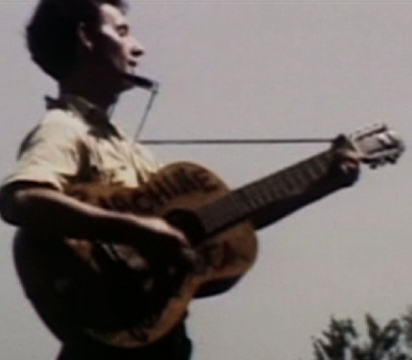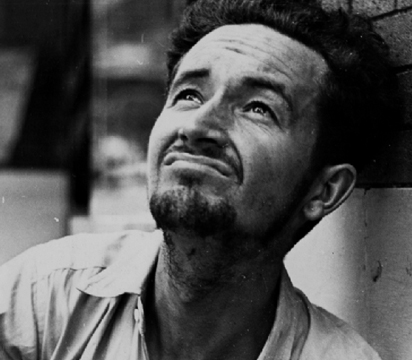
Woody wrote this song around 1941. According to Pete Seeger, he read about the Italian Hall disaster in Mother Bloor’s autobiography We Are Many, published in 1940. (Woody’s own notes confirm that he got the idea for the song “from the life of Mother Bloor.”)
Ella Reeve “Mother” Bloor was an eyewitness to the events at Italian Hall on Christmas Eve, 1913. A socialist and a labor organizer from the East Coast, Bloor was in Calumet working on the miners’ behalf with the Ladies Auxiliary of the Western Federation of Miners. She was greatly assisted in this work by Annie Clemenc, also known as Big Annie of Calumet — the “lady” in Woody’s song who hollers “‘there’s no such a thing! / Keep on with your party, there’s no such a thing.'”
Bloor tells the story of the Calumet strike and the Italian Hall disaster in the first half of a chapter called “Massacre of the Innocents.” She devotes the second half of the chapter to events in Ludlow, Colorado in 1914, the subject of another Woody Guthrie song — “Ludlow Massacre.”
Woody’s song echoes the language of Bloor’s account in many places. The historian Arthur W. Thurner has found similar accounts in English and Finnish-language newspapers from the period; these accounts, he says, probably originated with Annie Clemenc.

There are conflicting stories about what actually happened that Christmas Eve and of who yelled fire in Italian Hall. These conflicts will probably never be resolved: they are themselves evidence of what Thurner calls a “war between capital and labor” in the Copper Country in 1913. This war manifested itself, even in 1913-1914, in a struggle over the story of what really transpired that Christmas Eve in Italian Hall.
The contest over what the event means (or should mean) is ongoing. Woody’s song counts as one of the more powerful —and certainly one of the best known — interpretations of the tragedy.
Woody’s version of the song is available on Struggle and on Hard Travelin’, and while “1913 Massacre” never became a folk standard, the song has been recorded and performed many times since Woody first typed it out. (He liked to work at the typewriter.) Among those who have done the song are Woody’s son Arlo Guthrie, Ramblin Jack Elliot, Scottish folksinger Alex Campbell, and Bob Dylan.
Dylan performed “1913 Massacre” at Carnegie Hall in 1961. He had been working with Woody during the late winter of that year. Apparently Woody had made him aware of the song’s connection (via Bloor’s book) to “Ludlow Massacre”; Dylan identified “1913 Massacre” as “one of a group of two” songs. Later, he set his own tribute to Woody Guthrie —”Song To Woody” — to the tune of “1913 Massacre.”
